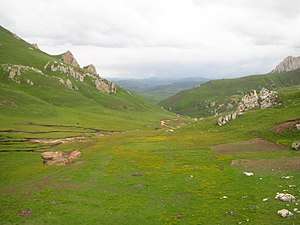Southeast Tibet shrub and meadows
The Southeast Tibet shrub and meadows are a montane grassland ecoregion that cover the southeast and eastern parts of the Tibetan Plateau in China. The meadows in this region of Tibet are in the path of the monsoon rains and are wetter than the other upland areas of the Tibetan Plateau. Chinese provinces covered by the Southeast Tibet shrub and meadows include the alpine parts of eastern Tibet Autonomous Region, the alpine parts of western and northern Sichuan, extreme southern and eastern Qinghai, and the montane areas of southern Gansu. Many mountain ranges support the Southeast Tibet meadows, stretching from the Nyainqêntanglha Mountains in the southwest to the Qilian Mountains in the northeast.[1]
| Southeast Tibet shrub and meadows | |
|---|---|
 Flowering summer meadows in Luqu County in the eastern Tibetan Pleateau | |
 Ecoregion territory (in purple) | |
| Ecology | |
| Realm | Palearctic |
| Biome | Montane grasslands and shrublands |
| Geography | |
| Countries | China and India |
Influenced by the Asian monsoon, he Southeast Tibet shrub and meadows experience seasonal climatic variation. Dry conditions in the winter lead to primarily brown landscapes, but summer rains revitalize grasses and turn the landscapes green. To the northwest, the meadows transition to the drier Tibetan Plateau alpine shrub and meadows.
Human activity is fairly high as the Southeast Tibet shrub and meadows provide grazing areas for domestic animals such as yak. While not well suited for most agriculture, pastoralist Tibetan people live across the region.[1] The northeastern part of this ecoregion was traditionally known as Amdo to Tibetans, while the southwestern part made up the higher elevation portions of Kham.
References
- "Southeast Tibet shrub and meadows". Global Species. Myers Enterprises II. Retrieved 21 August 2017.